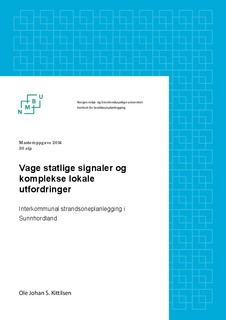| dc.description.abstract | This study examines the inter-municipal planning effort for the Sunnhordland shoreline organized in accordance with the regulations of chapter 9 in the Planning and Building Act (PBA). I investigate to what degree the planning effort corresponds to the ideals of coordination and consensus as laid down in the PBA and communicative planning theory. The ideals of broad participation and inclusion of all affected and relevant considerations and interests in the PBA are influenced by deliberative democracy theory (Falleth og Saglie 2012). However research on both local and regional planning has shown that
practice often differs from the communicative ideal (Falleth og Hanssen 2009, Skjeggedal 2005). Studies from Norway, Sweden and Finland have on the contrary shown that even if planning processes appear to be influenced by early and broad participation, in reality the processes may hide deep conflicts and hinder participation from having any influence (Mäntysalo et al 2011).
I argue that the discussion of basic conflicts is essential to reach more than a superficial consensus potentially hindering coordination.Even if the PBA requires early and broad participation the act does not give the same guidance on how interests and considerations are to be prioritized. Because of this the responsibility to safeguard and
prioritize between the affected interests and considerations is delegated to the local planning authority. However as the study shows there is a strong mutual dependency between the local, the regional planning authority and sector authorities creating tensions in the planning system. Central government planning guidelines for a differentiated management of the shoreline (CPG) are meant to clarify the
national policy of the 100-meter belt along the shore. The experiences of this study suggest that this goal is reached only partially. Neither PBA nor CPG seem to make it easier to reach a consensus on use and protection. On the contrary it seems as if the CPG for zone 3: areas with less pressure, are so vague that they may further spur already existing conflicts. The study investigates the tool of functional shoreline as a basis of decisions concerning land-use and -protection. The importance of an interactive contact between planner and decision-makers in complex and subjective land-use planning related issues is emphasized. Even if one has agreed on functional shoreline and a pilot pre-study as the basis of decision-making, reaching agreement on which
considerations and interest to give preference to has proved more difficult. Using Stokke and Hovik’s (2007) grading of levels of coordination it seems the common effort has reached a coordination of information and process, whilst it remains to be seen whether one reaches a coordination of content. As planning processes seem to become ever more complex and with local authorities committing to cooperative efforts the literature has focused on how local decision-makers may affect the interactions
within networks (Holmen og Hanssen 2013). One of the goals of this study is to build on experiences concerning challenges that politicians, municipal managers and project leaders face when trying to arrange more effective, transparent and democratic processes in complex and comprehensive land-use issues. Theories of meta-governance are introduced and discussed in relation to this.
Dette studiet tar for seg det interkommunale plansamarbeidet for strandsonen I Sunnhordland organisert etter plan- og bygningslovens (PBL) regler i kapittel 9. Jeg undersøker i hvilken grad det interkommunale plansamarbeidet samsvarer med idealene om samordning og konsensus slik de er nedfelt i hhv. PBL og kommunikativ planteori. Idealene om bred medvirkning og inkludering av alle berørte og relevante hensyn og interesser i PBL er påvirket av deliberativ demokratiteori (Falleth og
Saglie 2012). Forskning på både kommunal og regional planlegging har imidlertid vist at praksis ofte ikke stemmer overens med det kommunikative idealet (Falleth og Hanssen 2009, Skjeggedal 2005). Studier fra både Norge, Sverige og Finland har faktisk vist at mens kommunale planprosesser tilsynelatendepreges av deltakelse og åpenhet, kan de i realiteten bidra til å skjule konflikter og hindre reell medvirkning (Mäntysalo et al 2011). Jeg argumenterer for viktigheten av å ta opp grunnleggende konflikter for å oppnå mer enn en overfladisk konsensus som potensielt hindrer samordning. Selv om
PBL gjennom en rekke bestemmelser fordrer en tidlig og bred medvirkningsprosess, gir loven ikke de samme føringene for hvordan hensyn og interesser skal avveies og prioriteres. Det gjør at ansvaret for å ivareta interesser og hensyn tillegges den lokale planmyndigheten. Som studiet viser er det imidlertid en sterk gjensidig avhengighet mellom lokale, regionale planmyndigheter og sektormyndigheter noe som
skaper spenninger i plansystemet. Statlige planretningslinjer for en differensiert forvaltning av strandsonen (SPR) fra 2011 er ment å tydeliggjøre den nasjonale politikken for 100-metersbeltet. Erfaringene fra studiet tilsier at dette i beste fall bare oppnås delvis. Verken lovverk eller SPR virker å gjøre det enklere for planarbeidet å oppnå enighet i spørsmål om bruk og vern. Faktisk virker det heller som at SPR for sone 3: områder med mindre press, er så vage at de bygger opp under eksisterende konflikter.
Studiet undersøker funksjonell strandsone som beslutningsgrunnlag for bruk og vern. Viktigheten av en interaktiv kontakt mellom planleggere og beslutningstakere i komplekse og subjektive planfaglige spørsmål understrekes. Selv om man gjennom funksjonell strandsonekartlegging og forstudie er enige om et felles beslutningsgrunnlag, har avveiningene mellom hensyn og interesser vist seg vanskeligere å
enes om. Med Stokke og Hoviks (2007) gradering av samordningsbegrepet til grunn, kan det sies at mens samarbeidet har oppnådd en samordning av prosess og informasjon, gjenstår fortsatt en del konfliktløsing før man oppnår samordning av innhold. Ettersom planprosesser blir stadig mer komplekse og lokale myndigheter inngår i samarbeid om oppgaveløsning har litteraturen rettet et fokus mot hvordan lokale beslutningstakere kan påvirke interaksjonen i nettverk (Holmen og Hanssen 2013). Det er
et mål med dette studiet å bygge erfaringer rundt de utfordringene politikere, rådmenn, prosjektledere etc møter i forsøket på å legge til rette for mer effektive, gjennomsiktige og demokratiske planleggingsprosesser i komplekse og omfattende arealspørsmål. Teorier om metastyring introduseres og drøftes i denne sammenheng | nb_NO |
